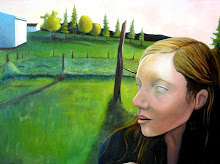I gave my first tour of the Pinchot mansion yesterday. Even though I gave tours all last summer at Daniel Boone, I was still nervous. My co-worker Joe Blanco went with me in case I felt like I needed him, and fellow intern Tori also came along for moral support. The people who were on my tour were very nice, and, sort of like at Boone, were interested in what I was saying but were not historians themselves. I started out by giving them a little background on the house and on Gifford Pinchot. Then I took them inside the Great Hall and talked to them about the Pinchot family, the activities that would have went on in the room, and some of the furniture and artwork. I also gave a few anecdotes about Cornelia. I took them through the library, sitting room, and outside to the fingerbowl, reflecting pool, letterbox, and the vista as well.
The key message that the Forest Service wants its tour guides to get accross is about Gifford Pinchot's contributions to conservation. This is awkward for me for several reasons. First, I don't really like to be told what to talk about on my tour. I find Cornelia Pinchot and her feminism to be very interesting and I like to talk about that just as much as Gifford. Secondly, Gifford didn't live in the house until he was already finished with his career as a professional forester and chief of the Forest Service. He lived in the house when he was Governor. So you are using the house to interpret a time period that predates it. Still, I found numerous ways to incorperate information about Gifford's conservation legacy when I took my group through the house. At the elk heads mounted on the wall I reminded everyone of Gifford's policy of "wise use" of natural resources. I talked about his trip to the South Pacific and how he loved to learn about biology and nature. I talk about the clearcutting that was done around Milford and point out that because of Pinchot, the surrounding area is now full of vegetation.
I don't want to make it seem like I am not interested in Pinchot's conservationism. Pinchot talked about natural resources in a way that I wish politicians would talk about them today. He was opposed to big bussiness dominating natural resources and creating monopolies. He thought that the timber in America's forests belong to everyone and that all Americans shoudl benefit from it, not just the men who own the logging companies. In regards to the management of natural resources he wrote in his autobiography that it should achieve, "the greatest good, of the greatest number, in the long run." This quote makes me think, would anyone working in the current administration say that about oil or any other resource today?
I was talking to a volunteer at Grey Towers yesterday, and she said something that really helped me create my tour. I had been feeling all week like there was a disconnect between the house and the story the Forest Service wanted me to tell. It's a mansion full of antiques, own by a really rich family. I kept wondering how I was supposed to tie that in with Gifford's ideas about conservation. This volunteer, whose name was Rita, said, "Yes, the Pinchots had this huge house,and they were very rich, but look at what they did with it." They didn't go out and try to make themselves richer. They tried to make this country a better place for everyone. That is the focus I wanted my tour to have. I am still developing it, but hopefully as the summer goes on I can convey that message, and make people think a little bit about how natural resources were managed 100 years ago, and today.
Subscribe to:
Post Comments (Atom)


No comments:
Post a Comment